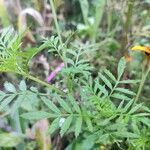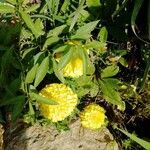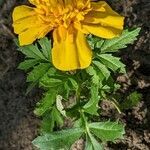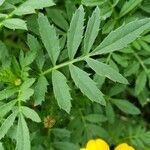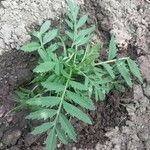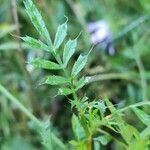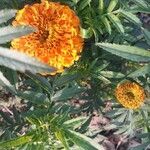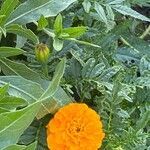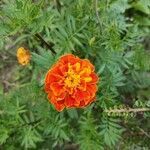Erect, glabrous, aromatic annual, up to c. 60 cm tall. Stems much-branched or sparingly branched. Lvs 1-pinnate, shortly petiolate; leaflets in 2-4-(8) pairs, narrow-elliptic to lanceolate, 1-4-(5) cm long, with 2-10-(20) teeth on each side, and scattered, large, sessile glands on both surfaces. Upper cauline lvs smaller than lower, with fewer, narrower leaflets and fewer leaflet teeth. Capitula c. 4-6 cm diam., solitary; peduncles fistular. Involucre campanulate, (12)-15-20 × (6)-8-18 mm, with 5-7 short teeth at apex; glands long, many, ± evenly distributed above and below. Ray florets 8-numerous; ligules pale yellow to bright orange, 10-30 mm long. Disc florets numerous, yellow or orange, or many or all transformed into ligulate florets. Achenes 3-4-angled, dark brown or black, moderately clothed in short antrorse hairs especially on angles, c. 10-11 × 1-1.3 mm; pappus scales fused toward base, the longest c. 11-12 mm and with minute marginal antrorse hairs.
Annual herbs 10–120 cm high. Stems glabrous. Leaves opposite to alternate, pinnately divided with 9–19 segments, glabrous; segments lanceolate to linear-lanceolate, 15–25 (–45) mm long, 3–8 (–12) mm wide, serrate, acute. Capitula solitary; peduncle 30–100 (–150) mm long; involucre cylindrical to campanulate, (3–) 5–12 mm diam. at anthesis; involucral bracts 5–8, connate except near apex. Ray florets (3–) 5–8 (–100 in ‘double’ cultivars); ligule (2–) 12–18 (–25) mm long, yellow to orange, red-brown or white (some cultivars). Disc florets (10–) 50–120; corolla 7–12 mm long. Achenes 6–11 mm long, dark brown to black. Pappus of 2–6 subulate aristate scales, the longest 6–12 mm long.
Annuals, 10-120 cm. Leaf blades 30-120(-250) mm overall, principal lobes/leaflets 9-25, lanceolate to linear-lanceolate, 15-25(-45) × 3-8(-12) mm. Capitula solitary; peduncles 30-100(-150) mm; involucres 10-22+ × (3-)5-12 mm; phyllaries 5-8. Ray florets (3-)5-8(-100 in "double" cultivars); lamina yellow to orange, red-brown (sometimes bi-colored: yellow/ red-brown), or white (some cultivars), flabellate to ovate-quadrate, (2-)12-18(-25) mm. Disk florets (10-)50-120; corollas 7-12 mm. Achenes 6-11 mm; pappus of 0-2 subulate-aristate scales 6-12 mm and 2-4 distinct or connate, linear-oblong, erose scales 2-6+ mm. Fl. Jun-Oct. 2n = 24, 48.
Annuals, 10–120+ cm. Leaf blades 30–120(–250+) mm overall, principal lobes/leaflets 9–25, lanceolate to lance-linear, 15–25(–45+) × 3–8(–12+) mm. Heads borne ± singly. Peduncles 30–100(–150+) mm. Involucres 10–22+ × (3–)5–12+ mm. Ray florets (3–)5–8+ (to 100+ in "double" cultivars); laminae yellow to orange, red-brown (sometimes particolored: yellow/red-brown), or white (some cultivars), ± flabellate to oval-quadrate, (2–)12–18(–25+) mm. Disc florets (10–)50–120+; corollas 7–12+ mm. Cypselae 6–11 mm; pappi of 0–2, ± subulate-aristate scales 6–12+ mm plus 2–4 distinct or connate, linear-oblong, ± erose scales 2–6+ mm. 2n = 24, 48.
florets, the corollas yellow, 10-20 mm long, the tube slender, the ligule broad, showy, entire to deeply cleft; disc florets 100-200, the corollas yellow, equally to very unequally 4-5-lobed, sometimes ciliate-margined or pubescent within, the anthers 2-3 mm long with short triangular appendages, the style branches elongate, slender. Achenes 6.5-9 mm long, black, angled, minutely pubescent on the angles or glabrous, narrowed to a shiny knoblike carpopodium; pappus of 1 or 2 stout, long-acuminate, flattened bristles 8-11 mm long and 2-3 more-or-less united truncate scales or bristles 3-6 mm long. Chromosome numbers n = 12 (24)
Annual herb 0.4–1.8 m high.. Leaves opposite, the upper alternate, elliptic in outline, pinnatisect with narrowly winged midrib, to 20 cm long, glabrous and glandular.. Capitula solitary, on long stalks which are thickened near the apex; involucre 12–20 mm long; phyllaries 5–8, connate, glabrous except for apex, glandular.. Ray florets 5–8, golden yellow, the ray 10–25 mm long; disc florets many, 10–16 mm long.. Achenes black, 7–10 mm long; pappus of 1–2 setae 6–12 mm long and 3–4 scales 3–5 mm long.
Annual herb 0.4-1.8 m high. Leaves opposite, the upper alternate, elliptic in outline, pinnatisect with narrowly winged midrib, to 20 cm long, glabrous and glandular. Capitula solitary, on long stalks which are thickened near the apex; involucre 12-20 mm long; phyllaries 5-8, connate, glabrous except for apex, glandular. Ray florets 5-8, golden yellow, the ray 10-25 mm long; disc florets many, 10-16 mm long. Achenes black, 7-10 mm long; pappus of 1-2 setae 6-12 mm long and 3-4 scales 3-5 mm long.
And T. patula L., the “French” marigold, both native to Mex., are widely cult. in double forms and occasionally escape. T. erecta has yellow or orange heads mostly 6–10 cm wide on fistulous peduncles, the invol ca 2 cm. T. patula has smaller, usually partly or wholly deep red-orange heads 3.5–5 cm wide on scarcely fistulous peduncles, the invol ca 1.5 cm.
A herb. It grows 0.5-1 m tall. It grows from seed each year. The stems are angular and green. The leaves are deeply lobed. The lobes are along the stalk. They also have coarse, sharp teeth. The flower heads are single. They have long stalks and are yellow. The fruit is dry.
Annual herb, up to 1 m high. Leaves pinnate, leaflets lanceolate, margins serrate. Heads solitary, on long peduncle which enlarges upwards. Pappus of scales united basally. Flowers light yellow to orange.
